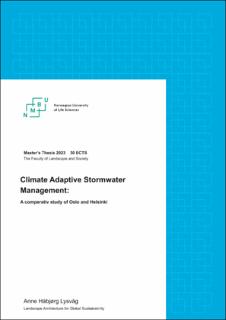| dc.description.abstract | The world is facing the consequences of climate change and needs to adapt. The increasing temperature is a central change and with it comes several consequences. One of these is an increase in precipitation, and therefore an increase in stormwater. In cities where the natural water cycle is disrupted, stormwater management is becoming a challenge. The main increase in precipitation will be during the winter. This will increase the amount of snow, meltwater and ice formation.
Helsinki and Oslo are both cities that are having to adapt to the increase in rain, snow, ice and meltwater. The thesis will be focused on comparing these two cities' stormwater management. To understand in which degree the cities are adapting to this challenge, documents in three different levels were analyzed. The documents covered the overall municipalities plan, the climate adaptive plan and the concrete stormwater plan.
By analyzing these documents, an opportunity to see the overview from overall to specific measure was achieved. It is important that the consistency from climate adaptation to local measures hold up, and that it is emphasized that this is a global situation which needs local action.
The discussion proved that the main research question:
To which extent is climate adaptation part of planning for the increasing challenge of stormwater management in Oslo and Helsinki?
should be answered in three distinct aspects:
* Managing and adapting to the general increase of precipitation during spring, summer, and fall.
* Handle the heavy rain expected during the summer months.
* Managing the increase in precipitation during the winter together with the changing climate conditions.
* Managing and adapting to the general increase of precipitation during spring, summer, and fall.
Both cities have adapted quite well to the general increase, with blue- green infrastructure and a goal of purifying the stormwater before it meets the sea or larger rivers.
* Handle the heavy rain expected during the summer months.
A bit more complex, both cities have this as a priority, but Oslo has included it in its strategy while Helsinki is working on it through pilot projects. The change here is due to differences in ownership in the respective municipalities.
* Managing the increase in precipitation during the winter together with the changing climate conditions.
Helsinki is one step ahead of Oslo here due to its very thorough weather and climate change risk report, and the Nasta strategy which brings up the issue of weather effects on traffic. Other than this strategy, Helsinki has, same as Oslo, no specific measures in place to handle stormwater management during the winter months.
Both Helsinki and Oslo have included climate adaptation measures in their planning to address the challenges of stormwater management. The two cities differ in the level of detail in stormwater management, and where the focus lies. The largest weakness they both have is the lack of specific measures in the winter. This is a crucial and significant part of stormwater management where there is little to no climate adaptive measures taken. | |
